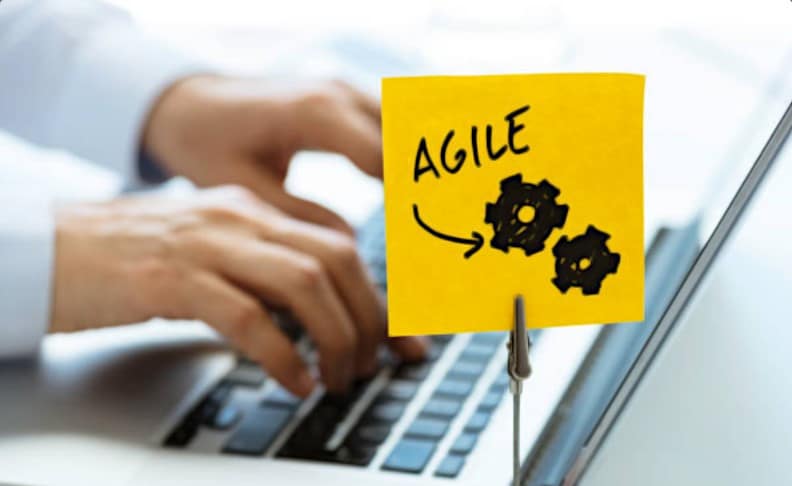Although agile project management methods are becoming increasingly popular within companies, not all teams use the same methods. So how do you coordinate the work of all your collaborators while maintaining a high level of agility? Simply use the Scaled Agile Framework. What is the Scaled Agile Framework? What are its founding principles? How does SAFe 5.0 work? We'll answer all your questions.
What is the Scaled Agile Framework?
The Scaled Agile Framework SAFe is a knowledge base for companies using agile methodologies in their business. The aim is to enable companies to maintain or develop their competitive edge in an increasingly digital world. Thanks to the principles, methods and work systems provided by SAFe, organisations have all the keys in hand to provide their customers with a continuous flow of value.
What are the main principles of SAFe?
As the Scaled Agile Framework is intended to apply to the whole company, these principles apply to all employees (whether they are decision-makers or not).
The economic vision
For SAFe principles to be applied effectively, all employees must adopt an economic vision. Everyone needs to understand the implications of late deliveries, defects and so on.
A better understanding of the economic benefits and trade-offs means that tasks can be carried out more smoothly, while respecting budgetary constraints.
Systems thinking
The Scaled Agile Framework encourages employees to take a step back. When they carry out an action, they must always think of its benefit for the solution, the company and the value streams (organisational processes, management, other teams, etc.). Through systems thinking, the aim is to optimise working methods.
Variability and options
SAFe is based on the concept of “set based design“. The idea is to consider several options when developing software. Customer needs, the market and technological innovations are constantly evolving. So to deliver a product that meets all expectations, teams have to learn to synchronise with variability.
Rapid, integrated learning cycles
To improve the software, delivery times and/or reduce costs, teams need to regularly evaluate the product. To do this, the Scaled Agile Framework recommends adopting the PDCA cycle. In other words, plan, do, check and adjust.

Objective assessment of work systems
It involves implementing an evaluation and verification system right from the start of the project. This encourages the development of systems thinking, and therefore of the Agile culture within the company.
Optimising work in progress
To work effectively, agile teams must first visualise all the stages in the process. This enables them to identify methods for optimising the work in progress. For example, reducing the volume of batches, the length of queues or avoiding overlapping tasks.
Planning a cadence
The Scaled Agile Framework encourages the definition of a cadence for all tasks. For example, meetings every morning to assess the work done: what has been done well, what needs to be improved, objectives achieved, objectives not achieved, adjustments to be made, etc.
Motivating teams
As employees are solely responsible for the implementation of an Agile methodology, SAFe encourages leaders to motivate them. This can take the form of personalised coaching, empowering teams, etc.
Decentralised decision-making
With the Scaled Agile Framework, decisions no longer have to be taken by a single decision-making body. Instead, all those involved in the project’s development can contribute their knowledge and point of view to the decision-making process.
Values at the heart of corporate strategy
SAFe is based on 5 fundamental values:
- Alignment ;
- Quality
- Transparency
- Programme execution;
- Leadership.
How does the Scaled Agile Framework work?
SAFe is built around the key competencies of Lean companies. These are used to define agile management processes.
Agile Teams
Scrum, Kanban, Scrumban, eXtreme Programming… Each agile team uses its own method to add maximum value to the business. But to bring true agility to the whole company, the principles of the Scaled Agile Framework are essential. The SAFe method aims to synchronise the connections that are established between teams.
Agile product delivery
To deliver maximum value to customers, agile teams work by iteration. The idea is to define a schedule with all the stages in the delivery process. As the project progresses, the team meets to measure progress, identify areas for improvement and adjust the next stages.
These iterations ensure that the right product is delivered to the right person at the right time.
Lean portfolio management
This involves ensuring both the strategy and the execution of agile methods. Lean portfolio management enables development solutions to be aligned with the company’s strategy.

Using this tool from the Scaled Agile Framework, companies can learn how to organise themselves better to deliver more value to customers, while reducing unnecessary costs.
Organisational agility
The Scaled Agile Framework provides organisations with a number of tools to ensure the agility required to adapt to customer needs. If these evolve, companies must be able to change direction quickly and reorganise the process in order to improve the quality of their products and services.
Continuous learning
Whether it’s to shorten time-to-market, increase product quality or improve safety, the Scaled Agile Framework aims to automate learning cycles. This involves implementing a virtuous circle: action -> verification -> adjustment -> planning -> action -> etc.
Lean Leadership
Product owner, Scrum master, Product manager… There are many agile managers. But beyond mastering the methodology, they must first and foremost embody, teach and demonstrate the Lean mindset and culture.
To do this, leaders must guide all employees towards a new working method by implementing a roadmap, a roadmap or an architectural guide.
Scaled Agile Framework for implementing enterprise-wide agility
Through its principles and methods, the Scaled Framework Agile aims to promote agility throughout the company. Implementing agile practices therefore requires a genuine change in culture and mindset, involving all employees. This upheaval in working methods is facilitated by the various SAFe tools.










